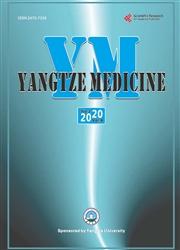A Comparative Study of Ultrasound-Guided Microwave Ablation, Surgery and Rotational Adenomammectomy for Benign Breast Nodules
引用次数: 0
Abstract
Objective: To explore the clinical effects of conventional surgery, ultrasoundguided microwave ablation and rotational adenomammectomy on the prognosis of benign breast nodules. Methods: 232 cases of patients with benign breast nodules confirmed by pathological examination who received surgical treatment in the breast surgery department of our hospital from December 2016 to December 2020 were included. According to the surgical methods, they were divided into microwave ablation group (n = 48), conventional surgery group (n = 105) and rotational adenomammectomy group (n = 79). The clinical parameters were compared and analyzed between the three groups, and the postoperative pain, residual tumor, breast beauty and complication rate of the patients were evaluated. Results: Operative time, intraoperative blood loss, healing time and postoperative pain in microwave ablation group were lower than those of rotational adenomammectomy group (P < 0.05) and those of conventional surgery group (P < 0.05). Besides, those in the rotational adenomammectomy group were lower than those in the conventional surgery group (P < 0.05). The residual tumor rates in microwave ablation group and rotational adenomammectomy group were 4.17% and 3.80%, respectively. And the difference was not statistically significant (P > 0.05). Both of them were lower than 6.66% in conventional surgery group, with statistically significant differences (P < 0.05). The effective rates of breast beauty were 91.67%, 82.28% and 68.58% in the microwave ablation group, the rotational adenomammectomy group and the conventional surgery group, respectively. And the difference between groups was statistically significant (P < 0.05). The rate of postoperative complications in microwave ablation group and rotational adenomammectomy group were 4.17% and 3.80% respectively, both of which were significantly lower than 6.66% in conventional surgery group (P < 0.05). Conclusion: Microwave ablation, rotational adenomammectomy and How to cite this paper: Zhang, M., Xu, W. and Liu, C. (2021) A Comparative Study of Ultrasound-Guided Microwave Ablation, Surgery and Rotational Adenomammectomy for Benign Breast Nodules. Yangtze Medicine, 5, 287-294. https://doi.org/10.4236/ym.2021.54026 Received: September 14, 2021 Accepted: December 25, 2021 Published: December 28, 2021 Copyright © 2021 by author(s) and Scientific Research Publishing Inc. This work is licensed under the Creative Commons Attribution International License (CC BY 4.0). http://creativecommons.org/licenses/by/4.0/ Open Access超声引导下微波消融、手术及旋转腺瘤切除术治疗乳腺良性结节的比较研究
目的:探讨常规手术、超声引导下微波消融及旋转腺瘤切除术对乳腺良性结节预后的影响。方法:选取2016年12月至2020年12月在我院乳腺外科接受手术治疗的经病理证实的乳腺良性结节患者232例。根据手术方式分为微波消融组(n = 48)、常规手术组(n = 105)和旋转腺瘤切除术组(n = 79)。比较分析三组患者的临床参数,评价患者术后疼痛、肿瘤残留、乳房美观及并发症发生率。结果:微波消融组手术时间、术中出血量、愈合时间、术后疼痛均低于旋转腺瘤切除术组(P < 0.05)和常规手术组(P < 0.05)。旋转腺瘤切除术组明显低于常规手术组(P < 0.05)。微波消融组和旋转腺瘤切除术组残留肿瘤率分别为4.17%和3.80%。差异无统计学意义(P < 0.05)。均低于常规手术组的6.66%,差异有统计学意义(P < 0.05)。微波消融组、旋转腺瘤切除术组和常规手术组的乳房美容有效率分别为91.67%、82.28%和68.58%。组间比较差异有统计学意义(P < 0.05)。微波消融组和旋转腺瘤切除术组术后并发症发生率分别为4.17%和3.80%,均显著低于常规手术组的6.66% (P < 0.05)。张敏,徐伟,刘超。(2021)超声引导下微波消融、手术及旋转腺瘤切除术治疗乳腺良性结节的比较研究。扬子医学,5,287-294。https://doi.org/10.4236/ym.2021.54026收稿日期:2021年9月14日收稿日期:2021年12月25日出版日期:2021年12月28日版权所有©作者与科研出版公司。本作品采用知识共享署名国际许可协议(CC BY 4.0)。http://creativecommons.org/licenses/by/4.0/开放获取
本文章由计算机程序翻译,如有差异,请以英文原文为准。
求助全文
约1分钟内获得全文
求助全文

 求助内容:
求助内容: 应助结果提醒方式:
应助结果提醒方式:


